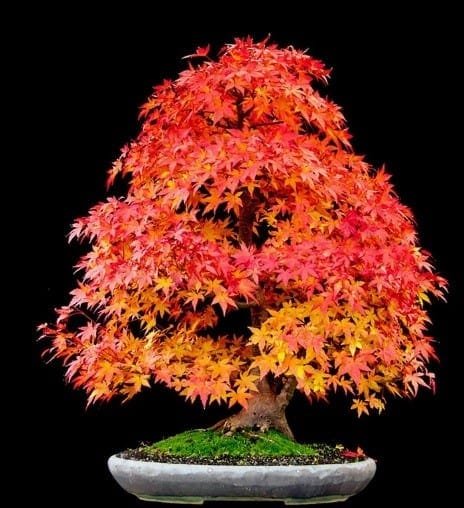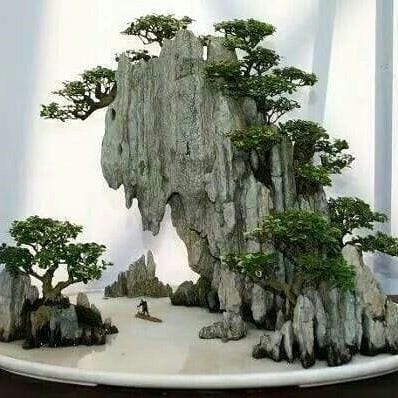Chinese penjing and its influences on Japanese bonsai relate in complex ways that further make it confusing for many newbie bonsai enthusiasts when it comes to distinguishing the differences between these two East Asian art forms.
For as much as penjing and bonsai are similar in the way miniature trees are cultivated in miniature containers, there are also important and unique traits in each of these methods of cultivating tiny trees.
Thus, it is only through tracing the history of Chinese penjing and its influences to Japanese bonsai that one can attain a clear understanding of what unites, as well as what sets apart the Chinese vs. the Japanese trace in the art of growing and admiring miniature trees.
Brief Introduction to the History of Penjing and Bonsai
It was in China where the first cultivation of various tiny trees and plants placed in small-sized ornamental pots began during the reign of the Tang Dynasty – the dynasty that ruled China from 618 to 907 CE.
Starting in the early 700s, the art of penjing was mostly restricted to the royal families.
Just about 200 years later, Buddhist monks brought penjing-styled miniature trees to Japan, and new chapters in the history of cultivating tiny trees were about to be written.
There are various theories regarding the very start of the popularization and further development of the Chinese penjing art form into the Japanese culture.
According to Iwasa Ryōji, who is a former professor emeritus at Chiba University, Japan, Chinese-style penjing was adopted by the Japanese as early as the Heian period.
Iwasa Ryōji’s theory was based on existing illustrations that depict the life of Japanese people during the Heian period (794-1185), showcasing tiny trees and stones placed in pots.
However, extensive modern-day research has put the precise dating of these illustrations under debate, and thus, Professor Iwasa Ryōji’s theory remains only an assumption.
Without any doubt, though, during the Kamakura period (1185-1333), the Japanese have already embraced the practice of cultivating miniature trees in miniature pots and embedded much of their deepest and most profound beliefs and traditions into the Chinese art of penjing, gradually giving birth to the art of bonsai.
Video by: bill wurtz – history of japan
Source: youtube.com
Interestingly, when it comes to the development of the Chinese art of penjing, some studies suggest that the practice of cultivating tiny trees as part of natural landscapes did not suffer such a great decline in China as other theories suggest.
In an extensive research paper titled Informal History of Bonsai, author Charles R. Long highlights that even though never reaching the same amazing popularity as the art of bonsai in Japan, the art of penjing in China continued to be practiced without facing oblivion for many centuries.
Penjing vs. Bonsai: Differences and Similarities
Chinese penjing refers to the process of creating miniature landscapes through growing different types of tiny trees alongside various natural and/or non-natural objects such as ground covers, rocks, and small figurines.

The art of penjing is much more unrestrained in terms of the different landscapes that can be brought to life – it is all about the imagination of the penjing artist.

Japanese bonsai encompasses the art and science behind cultivating miniature trees or shrubs in tiny containers in order to achieve an authentic miniature version of the way a tree/shrub would grow freely in the wilds.

It is through regular pruning, re-potting, and training of the trunk and branches that bonsai trees achieve the desired shape and highly praised aged appearance.

In both the art of penjing, as well as the art of bonsai, trees are shaped through various methods of regular pruning, trimming, and/or wiring, among others.
These tiny trees are not genetically dwarfed plants – they simply remain tiny in size due to the techniques applied by the bonsai or penjing gardeners.
In the living nature, trees can live for hundreds of years. In fact, some species can live for thousands of years.
But when introduced to the art of penjing or bonsai, trees can live for an indefinite period and easily outlive their natural counterparts – thanks to the constant promotion of new growth.
Highly influenced by the concepts of Taoism, Zen Buddhism, and Confucianism, bonsai, and penjing are related in a sacred and meaningful way.
Even though the art of bonsai was influenced by penjing, it managed to find its own light and character through the Japanese traditions.
Chinese Penjing and its Influence to Bonsai: Final Thoughts

Although considered by some as merely a decorative attribute, the major purpose of placing various tiny figures while creating a miniature landscape in the art of penjing intends to put a spotlight on the relationship between people and the living nature.
Quintessentially, this is similar to the way the art of bonsai aims to highlight and represent the majestic power and beauty of nature as to invoke a sense of nostalgia and higher awareness over the profound connection of mankind in appreciating and protecting the living nature.
Complexly intertwined, it is hard to define the exact ways in which Chinese penjing and its influence on Japanese bonsai have been interacting with each other throughout the centuries. But as much as these art forms are different, the joy of witnessing the power of the living nature in a miniature version is equally influential and hard to put into words, for it is best experienced with the heart.


